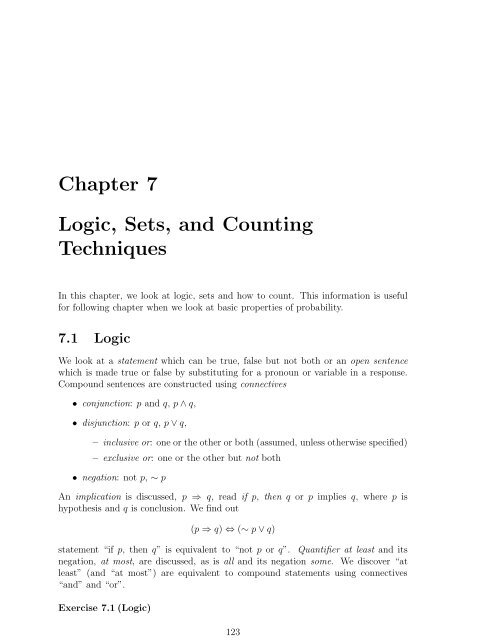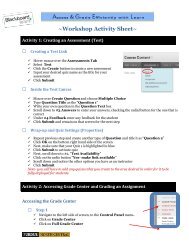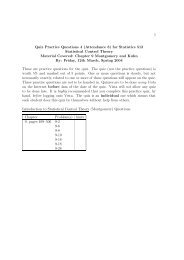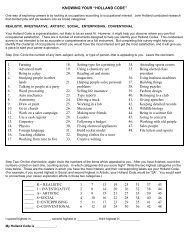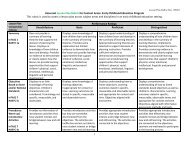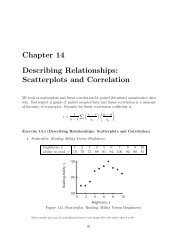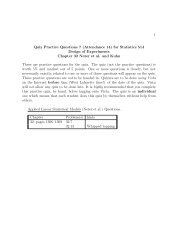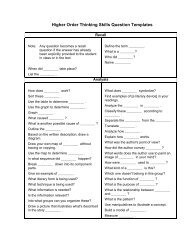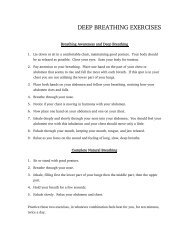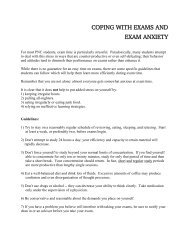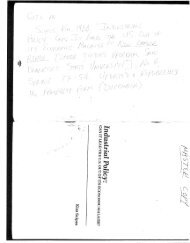class lecture notes 8
class lecture notes 8
class lecture notes 8
You also want an ePaper? Increase the reach of your titles
YUMPU automatically turns print PDFs into web optimized ePapers that Google loves.
Chapter 7Logic, Sets, and CountingTechniquesIn this chapter, we look at logic, sets and how to count. This information is usefulfor following chapter when we look at basic properties of probability.7.1 LogicWe look at a statement which can be true, false but not both or an open sentencewhich is made true or false by substituting for a pronoun or variable in a response.Compound sentences are constructed using connectives∙ conjunction: p and q, p∧q,∙ disjunction: p or q, p∨q,– inclusive or: one or the other or both(assumed, unless otherwise specified)– exclusive or: one or the other but not both∙ negation: not p, ∼ pAn implication is discussed, p ⇒ q, read if p, then q or p implies q, where p ishypothesis and q is conclusion. We find out(p ⇒ q) ⇔ (∼ p∨q)statement “if p, then q” is equivalent to “not p or q”. Quantifier at least and itsnegation, at most, are discussed, as is all and its negation some. We discover “atleast” (and “at most”) are equivalent to compound statements using connectives“and” and “or”.Exercise 7.1(Logic)123
124 Chapter 7. Logic, Sets, and Counting Techniques (LECTURE NOTES 8)1. Statements and connectives. Consider following statementsp: Student registered at PNC.q: Student disabled.(a) p∧q meansi. Student registered at PNC and disabled.ii. Student registered at PNC or disabled.(b) p∨q meansi. Student registered at PNC and disabled.ii. Student registered at PNC or disabled.(c) p∧ ∼ q meansi. Student registered at PNC and able-bodied.ii. Student not registered at PNC or disabled.(d) p ⇒∼ q meansi. If student registered at PNC, then they are able-bodied.ii. Student registered at PNC or able-bodied.(e) ∼ p∧ ∼ q meansi. Student not registered at PNC and able-bodied.ii. Student not registered at PNC and disabled.(f) Student registered at PNC and is disabled:i. p∧ ∼ qii. p∧q(g) Student is not registered at PNC and is disabled:i. ∼ p∧qii. ∼ p∧ ∼ q(h) Student registered at PNC or is able-bodied:i. p∨ ∼ qii. p∨q(i) Negation of p∧q (choose one or more)i. (∼ p∧ ∼ q)∨(∼ p∧q)∨(p∧ ∼ q)ii. p ⇒∼ qiii. ∼ p∨ ∼ q
Section 1. Logic (LECTURE NOTES 8) 1252. More statements and connectives. Consider following statementsp: Student owns iPhone.q: Student tweets.(a) ∼ p∧q meansi. Student owns iPhone and tweets.ii. Student does not own iPhone and tweets.(b) p∨ ∼ q meansi. Student owns iPhone or does not tweet.ii. Student does not own iPhone or tweets.(c) ∼ p∨ ∼ q meansi. Student does not own iPhone and does not tweet.ii. Student does not own iPhone or does not tweet.(d) If student owns iPhone, then student tweets:i. p∧qii. p ⇒ q(e) Student does not own iPhone and does not tweet:i. ∼ p∧qii. ∼ p∧ ∼ q(f) Student owns iPhone or tweets, inclusively:i. (p∧ ∼ q)∨(∼ p∧q)ii. p∨q equivalent to (p∧ ∼ q)∨(∼ p∧q)∨(p∨q)(g) Student owns iPhone or tweets, exclusively:i. (p∧ ∼ q)∨(∼ p∧q)ii. p∨q equivalent to (p∧ ∼ q)∨(∼ p∧q)∨(p∨q)(h) p ⇒ q means (choose one or more)i. If student owns iPhone, then student tweets.ii. Student does not own iPhone or tweets, meaning one of three things:Student owns iPhone and tweets, orStudent does not own iPhone and does not tweet, orStudent does not own iPhone and tweets.This demonstrates p ⇒ q is equivalent to ∼ p ∨q.3. At least and at most; some and all.(a) “At least four of five students tweet” equivalent to (choose two!)
126 Chapter 7. Logic, Sets, and Counting Techniques (LECTURE NOTES 8)i. four students tweet or five students tweet.ii. (four students tweet and one does not) or (five students tweet and zerodo not)iii. at most three students tweets.(b) Negation of “At least four of five students tweet” isi. four students tweet or five students tweet.ii. (four students tweet and one does not) or (five students tweet and zerodo not)iii. at most three students tweet.(c) “At most two of five students tweet” equivalent toi. zero students tweet or one student tweet or two students tweet.ii. at least three students tweet.(d) Negation of “All students tweet” (choose two!)i. Some students do not tweet.(Which could mean all students do not tweet, but at least one does not tweet.)ii. Not all students tweet.iii. Some students tweet.(Which could mean all students tweet, not the negation of “all students tweet”.)(e) Negation of “Some students do not own an iPod” (choose one)i. Some students own an iPod.(Which could mean some students do not own an iPod,not the negation of “some students do not own an iPod”.)ii. All students own an iPod.iii. All students do not own an iPod.(Which could mean some students do not own an iPod, so not a negation.)(f) Negation of “Student owns iPod and tweets” (choose one or more)i. (student owns iPod and does not tweet)or (student does not own iPod and tweets)or (student does not own iPod and does not tweet).ii. Student does not own iPod or does not tweet.In general, ∼ (p∧q) ≡∼ p∨ ∼ q(g) Negation of “Student owns iPod or tweets”i. Student owns iPod and tweets.ii. Student does not own iPod and does not tweet.In general, ∼ (p∨q) ≡∼ p∧ ∼ q
Section 2. Truth Tables (LECTURE NOTES 8) 1277.2 Truth TablesWhen combining two statements, p and q, which each have two possible values, true(T) or false (F), there are always only four possibilities,p qT TT FF TF FTwo statements arelogically equivalentif theyhave identical truthvalues anddenotedp ≡ q. DeMorgan’s Laws of Logic are given by∙ ∼ (p∧q) ≡∼ p∨ ∼ q∙ ∼ (p∨q) ≡∼ p∧ ∼ qExercise 7.2(Truth Tables)1. True or False?(a) T / F. If it is a German Shepherd, then it is a dog.(b) T / F. If it is a dog, then it is a German Shepherd.(c) T / F. 2−1 = 1 and 5×2 = 11.(d) T / F. 2−1 = 1 or 5×2 = 11.2. Truth tables. Fill in blanks.(a) p∧q(b) p∨qp q p∧q exampleT T T 2−1 = 1 and 5×2 = 10T F F 2−1 = 1 and 5×2 = 11F T 2−1 = 0 and 5×2 = 10F F 2−1 = 0 and 5×2 = 11p q p∨q exampleT T 2−1 = 1 or 5×2 = 10T F 2−1 = 1 or 5×2 = 11F T 2−1 = 0 or 5×2 = 10F F 2−1 = 0 or 5×2 = 11
128 Chapter 7. Logic, Sets, and Counting Techniques (LECTURE NOTES 8)(c) p ⇒ q(d) ∼ p∨qp q p ⇒ qT TT FF TF Fp q ∼ p ∼ p∨qT T FT F FF T TF F T3. Equivalences using truth tables.(a) p∨q and q ∨pp q p∨q q ∨pT T T TT F T TF T T TF F F FSo p∨q and q ∨p are equivalent / not equivalent(b) p ⇒ q and ∼ p∨qp q p ⇒ q ∼ p ∼ p∨qT T T F TT F F F FF T T T TF F T T TSo p ⇒ q and ∼ p∨q are equivalent / not equivalent4. DeMorgan’s laws of logic. Consider following statementsp: Student owns iPhone.q: Student tweets.(a) Since ∼ (p∧q) ≡∼ p∨ ∼ q, this meansi. Student does not own iPhone or does not tweet.ii. Student does not own iPhone and does not tweet.(b) ∼ (p∨q) ≡∼ p∧ ∼ q
Section 3. Sets (LECTURE NOTES 8) 129i. Student does not own iPhone or does not tweet.ii. Student does not own iPhone and does not tweet.7.3 SetsAfter looking at some definitions related to sets, we look at intersection, union, complementand difference of sets. Venn diagrams help us picture these various operations.Exercise 7.3(Sets)1. Definitions.(a) True / False. Set is well-defined collection of distinct objects (rule allowsus to determine if object belongs to a set or not); for example, “set ofletters in English alphabet” is a set but “set of letters” is not a set.(b) True / False. Set A of 1, 2, 3, 4, 5, 6 denoted A = {1,2,3,4,5,6}.(c) True / False. If A = {1,2,3,4,5,6}, then number 6 belongs to A, 6 ∈ A.(d) True / False. If A = {1,2,3,4,5,6}, then 7 does not belong to A, 7 ∕∈ A.(e) True / False. a ∈ A read a is an element of A.(f) True / False. Set Aof all numbers between 0 and 5: A = {x : 0 < x < 5}.(g) True / False. Set B subset of A, B ⊆ A, if and only if each element of Bis also an element of A; for example, B = {2,3} and A = {x : 0 ≤ x ≤ 5}.(h) True / False. Sets B and A equal, A = B, if and only if B ⊆ A andA ⊆ B, if both sets contain exactly same elements.(i) True / False. If A = {x : 0 ≤ x ≤ 5} and B = {0,1,2,3,4,5}, thenA ∕= B.(j) True / False. Set containing no elements is empty set denoted Ø.(k) True / False. Set containing all elements is universal set, U.2. Venn diagrams: intersection and union.
130 Chapter 7. Logic, Sets, and Counting Techniques (LECTURE NOTES 8)AUAUCCBB(a)Figure 7.1(Venn diagrams: intersection and union)(a) Figure (a), intersection of A and C, A∩C, all elements in both A and C,{x : (x ∈ A) or (x ∈ C)} / {x : (x ∈ A) and (x ∈ C)}(b) Figure (b), union of A and C, A∪C, elements in either A or C,{x : (x ∈ A) or (x ∈ C)} / {x : (x ∈ A) and (x ∈ C)}(c) General intersection.Intersection A 1 ∩A 2 ∩...∩A n equivalent to{x : x belongs to every set }{x : x belongs to at least one of the sets }(d) General union.Union A 1 ∪A 2 ∪...∪A n equivalent to{x : x belongs to every set }{x : x belongs to at least one of the sets }(e) Notation. Often, “∩” dropped, so A∩B becomes AB for example.Consequently, (A∩B)∪(A∩C) equivalent to(AC ′ ) ∪ (BC ′ ) ∪ (AB) / (AB) ∪(AC) / (A ∪ B) ′3. Venn diagrams: difference and complement.(b)AUAUCCBB(a)Figure 7.2(Venn diagrams: difference and complement)(b)
Section 3. Sets (LECTURE NOTES 8) 131(a) Figure (a), difference A−C, elements of A not in C:{x : (x ∈ A) and (x ∕∈ C)} / {x : (x ∈ U) and (x ∕∈ C)}(b) Figure (b), complement of C, C ′ , elements of U not in C:{x : (x ∈ A) and (x ∕∈ C)} / {x : (x ∈ U) and (x ∕∈ C)}4. More Venn diagrams.U U UE E EGGGF F F88 8(a) (b) (c)Figure 7.3(More Venn diagrams)(a) Shading in figure (a):(E − G) ∪(F − G) ∪ (E ∩ F) / (E ∩ F)∪(E ∩ G) / (E ∪ F) ′(b) Shading in figure (b):(E − G) ∪(F − G) ∪ (E ∩ F) / (E ∩ F)∪(E ∩ G) / (E ∪ F) ′(c) Shading in figure (c):(E − G) ∪(F − G) ∪ (E ∩ F) / (E ∩ F)∪(E ∩ G) / (E ∪ F) ′(d) True / False. E −G = E ∩G ′ and F −G = F ∩G ′5. Word problem. Of students registered at PNC, let D represent those who aredisabled, I those who own an iPhone and T those who tweet.DU U UDDTTTIII(a) (b) (c)Figure 7.4(Students at PNC)
132 Chapter 7. Logic, Sets, and Counting Techniques (LECTURE NOTES 8)(a) Students registered at PNC represented by set D / I / T / U(b) Shaded region of figure (a) represents studentsi. disabled who own iPhones or disabled who tweet.ii. disabled who do not tweet, or iPhone owners who do not tweet ordisabled who own iPhonesiii. registered at PNC who are not (disabled or own iPhones)(c) Shaded region of figure (b) represents studentsi. disabled who own iPhones or disabled who tweet.ii. disabled who do not tweet, or iPhone owners who do not tweet ordisabled who own iPhonesiii. registered at PNC who are not (disabled or own iPhones)(d) Shaded region of figure (c) represents studentsi. disabled who own iPhones or disabled who tweet.ii. disabled who do not tweet, or iPhone owners who do not tweet ordisabled who own iPhonesiii. registered at PNC who are not (disabled or own iPhones)6. Set operations. LetE 1 = {a,b,c,d,e,f},E 2 = {e,f,g,h},E 3 = {i}and the universal set is U = {a,b,c,d,e,f,g,h,i,j}.E1a b c de fiEU3E2g hjFigure 7.5(Set operations)(a) Notice E ′ 1 = {g,h,i,j},so E ′ 2 = {g,h,i,j} / {a,b,c,d} / {a,b,c,d,i,j}(b) Since E 1 ∪E 2 = {a,b,c,d,e,f,g,h}and E 2 ∪E 1 = {g,h,i,j} / {a,b,c,d} / {a,b,c,d,e,f,g,h}then E 1 ∪E 2 = E 2 ∪E 1 (commutative law)
Section 4. Application of Venn Diagrams (LECTURE NOTES 8) 133(c) Since E 1 ∩E 2 = E 1 E 2 = {e,f}and E 2 E 1 = {e,f} / {a,b,c,d} / {a,b,c,d,e,f,g,h}E 1 E 2 = E 2 E 1 (commutative law)(d) True / False Intersection of set E 1 and complement, E 1 ′ , is empty set,E 1 E 1 ′ = Ø. (Can anything be both in a set and not in a set at same time?)(e) Notice E 2 −E 1 = {g,h}and E 1 −E 2 = {e,f} / {a,b,c,d} / {a,b,c,d,e,f,g,h}so E 2 −E 1 ∕= E 1 −E 27. Sets and Logic.True / False If set P consists of elements which make statement p true and setQ consists of elements which make statement q true, sets and logic translate asfollowsstatement truth setsand: p∧q intersection: P ∩Qor: p∨q union: P ∪Qnegation: ∼ p complement: P ′p∧ ∼ q difference: P −Q = P ∩Q ′7.4 Application of Venn DiagramsWe look at how to carefully analysis Venn diagrams, and at various properties of sets,as well how some counting principles:∙ Inclusion-exclusion principle. “Or” means “add”, but do not double-count:n(A∪B) = n(A)+n(B)−n(A∩B)n(A∩B) = n(A)+n(B)−n(A∪B)∙ Complement principle.n(A) = n(U)−n(A ′ )Exercise 7.4(Application of Venn Diagrams)1. Labeling Venn diagrams.
134 Chapter 7. Logic, Sets, and Counting Techniques (LECTURE NOTES 8)U U U1 E E E4 115442 355G 2 32 3GG6F 766F 7F 7888(a) (b) (c)Figure 7.6(Venn diagrams)(a) Shaded region figure (a). Fill in blank.Set region labelsE 1,2,3,4F 2,3,6,7G 3,4,5,6(E ∩F)∪(E ∩G)(b) Shaded region figure (b). Fill in blank.Set region labelsE 1,2,3,4F 2,3,6,7G 3,4,5,6(E −G)∪(F −G)∪(E ∩F)(c) Shaded region figure (c). Fill in blank.Set region labelsE 1,2,3,4F 2,3,6,7G 3,4,5,6(E ∪F) ′2. More Venn diagrams and labeling. LetE 1 = {a,b,c,d,e,f},E 2 = {e,f,g,h},E 3 = {i}and the universal set is U = {a,b,c,d,e,f,g,h,i,j}.
Section 4. Application of Venn Diagrams (LECTURE NOTES 8) 135E1a b c de fiEU3E2g hjFigure 7.7(Venn diagrams and counting)(a) Since E 1 ∩E 2 = E 1 E 2 ={e,f} / {a,b,c,d} / {a,b,c,d,i,j}then (E 1 E 2 )E 3 = {e,f} / {a,b,c,d} / ØOn the other hand, sinceE 2 E 3 = {e,f} / {a,b,c,d} / Øthen E 1 (E 2 E 3 ) = {e,f} / {a,b,c,d} / ØSo (E 1 E 2 )E 3 = E 1 (E 2 E 3 ) (associative law)(b) True / False E 1 ∪(E 2 ∪E 3 ) = (E 1 ∪E 2 )∪E 3 (associative law)(c) Since E 1 ∪E 2 ={e,f} / {a,b,c,d} / {a,b,c,d,e,f,g,h}then (E 1 ∪E 2 )E 3 = {e,f} / {a,b,c,d} / Øon the other hand, sinceE 1 E 3 = {e,f} / {a,b,c,d} / Øand E 2 E 3 = {e,f} / {a,b,c,d} / Øthen E 1 E 3 ∪E 2 E 3 = {e,f} / {a,b,c,d} / Øand so (E 1 ∪E 2 )E 3 = E 1 E 3 ∪E 2 E 3 (distributive law)(d) True / False(E 1 ∪E 3 )(E 2 ∪E 3 ) = E 1 E 2 ∪E 1 E 3 ∪E 3 E 2 ∪E 3 E 3= E 1 E 2 ∪Ø∪Ø∪E 3= E 1 E 2 ∪E 3(e) Since E 1 ∪E 2 ={e,f} / {a,b,c,d} / {a,b,c,d,e,f,g,h}then (E 1 ∪E 2 ) ′ = {e,f} / {a,b,c,d} / {i,j}on the other hand, sinceE 1 ′ = {g,h,i,j} / {a,b,c,d} / Øand E 2 ′ = {e,f} / {a,b,c,d} / {a,b,c,d,i,j}then E 1E ′ 2 ′ = {e,f} / {a,b,c,d} / {i,j}and so (E 1 ∪E 2 ) ′ = E 1 ′ E′ 2 (DeMorgan’s Laws).
136 Chapter 7. Logic, Sets, and Counting Techniques (LECTURE NOTES 8)(f) True / False (E 1 E 2 ) ′ = E ′ 1 ∪E ′ 2 (DeMorgan’s Laws)3. Venn diagrams and counting.Let A = {a,b,c,d,e,f},B = {b,d,e,h},C = {a,e}and the universal set is U = {a,b,c,d,e,f,g,h,i,j}. Let n be “number”.AcbdfeaUCBhgi jFigure 7.8(Venn diagrams and counting)(a) n(A) = n{a,b,c,d,e,f} = 5 / 6(b) n(B) = n{b,d,e,h} = 1 / 2 / 3 / 4,(c) n(C) = n{a,e} = 1 / 2 / 3 / 4,(d) n(A∩B) = n{b,d,e} = 1 / 2 / 3 / 4,(e) n(A∩C) = n{a,e} = 1 / 2 / 3 / 4,(f) n(B ∩C) = n{e} = 1 / 2 / 3 / 4,(g) n(A∩B ∩C) = n{e} = 1 / 2 / 3 / 4,(h) n(A∪B) = n(A)+n(B)−n(A∩B) == n{a,b,c,d,e,f}+n{b,d,e,h}−n{b,d,e} = 5 / 6 / 7 / 8,(i) n(A∪C) = n{a,b,c,d,e,f} = 5 / 6 / 7 / 8,(j) n(B ∪C) = n{a,b,d,e,h} = 5 / 6 / 7 / 8,(k) n(A∪B ∪C) == n(A)+n(B)+n(C)−n(A∩B)−n(A∩C)−n(B∩C)+n(A∩B∩C) == n{a,b,d,c,e,f,h} = 5 / 6 / 7 / 8 / 9,(l) n(A ′ ) = n(U)−n(A) = n{g,h,i,j} = 1 / 2 / 3 / 4,(m) n(B ′ ) = n{a,c,f,g,i,j} = 5 / 6 / 7 / 8,(n) n(C ′ ) = n{b,c,d,f,g,h,i,j} = 5 / 6 / 7 / 8,(o) n(A ′ ∩B ′ ) = n{g,i,j} = 1 / 2 / 3 / 4,
Section 4. Application of Venn Diagrams (LECTURE NOTES 8) 137(p) n(A ′ ∪B ′ ) = n(A ′ )+n(B ′ )−n(A ′ ∩B ′ ) == n{g,h,i,j}+n{a,c,f,g,i,j}−n{g,i,j} = 5 / 6 / 7 / 8,(q) n(A ′ ∪C ′ ) = n(A ′ )+n(C ′ )−n(A ′ ∩C ′ ) == n{g,h,i,j}+n{b,c,d,f,g,h,i,j}−n{g,h,i,j} = 5 / 6 / 7 / 8.(r) n(A ′ ∪C) = n(A ′ )+n(C)−n(A ′ ∩C) == n{g,h,i,j}+n{a,e}−n{Ø} = 5 / 6 / 7 / 8,4. More counting.Study investigates effect of nutritional level on plant growth.nutritional level → poor adequate excellent row totalsplant below average 100 75 65 240growth above average 60 50 40 150column totals 160 125 105 390(a) n(below average growth) = 100 / 160 / 240(b) n(poor nutrition) = 100 / 160 / 240(c) n(below average growth and poor nutrition) = 100 / 160 / 240(d) n(below average growth or poor nutrition) =n(belowavegrowth)+n(poornutr)−n(belowaver growthandpoornutr)= 100 / 300 / 400


